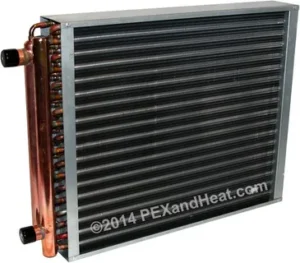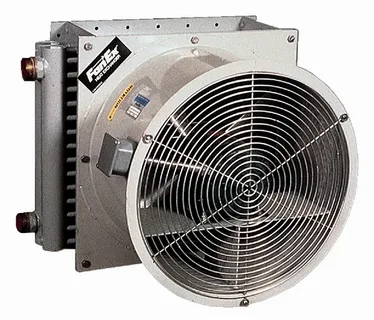In today’s world, managing heat efficiently in homes has become a top priority for homeowners. A key technology that has revolutionized heat management in residential settings is the hot air exchanger. This innovative system helps to regulate and maintain optimal temperatures inside homes, ensuring comfort and energy efficiency. In this blog post, we will delve into the world of hot air-exchangers, exploring how they work, their significance in residential settings, the types available, the installation process, maintenance tips, and more.
Understanding the Basics of Air to Air Heat-Exchangers
Air-to-air heat-exchangers, pivotal components in residential heating and cooling systems, function on a simple yet effective principle: they transfer heat without mixing two distinct air streams. These devices harness the thermal energy in indoor air, which would otherwise be expelled outside, to warm incoming fresh air. The operation hinges on a network of tubes or plates that facilitate heat exchange, ensuring that the two airflows—though never mingling directly—can transfer heat efficiently.
This mechanism is crucial for reducing energy consumption as it leverages existing warmth in the home, thereby diminishing the workload on conventional heating systems. The essence of air-to-air heat-exchangers lies in their ability to conserve energy while maintaining a comfortable indoor environment, making them an essential element in modern, energy-conscious homes. By capitalizing on this exchange process, homeowners benefit from a sustainable way to manage indoor temperatures and ensure a flow of fresh, clean air.
How Air Heat Exchanger Works to Improve Your Home?
Air heat exchanger serves as a bridge for energy transfer between indoor and outdoor environments, operating on a principle that optimizes your home’s heating and cooling systems. These systems make heating your home more efficient by capturing heat from outgoing indoor air and transferring it to incoming outdoor air. During colder months, the heat exchanger warms up the cooler outdoor air with the heat extracted from the indoor air that’s being expelled.
Conversely, the system can remove excess heat from the incoming air in warmer seasons, using the cooler indoor air that’s on its way out. This dual action ensures a constant supply of fresh air and minimizes reliance on external heating and cooling sources, leading to significant energy savings. Additionally, this heat exchange method maintains a balanced humidity level, which contributes to a more comfortable indoor atmosphere, enhancing the overall living environment without repeating related sections’ initial or concluding remarks.
The Significance of Hot Air-Exchangers in Residential Settings
Hot air-exchangers have become indispensable tools for achieving a healthier, more energy-efficient home environment. These systems excel in ventilating a house, simultaneously removing stale indoor air and drawing in fresh outdoor air, thus directly combating indoor pollutants, allergens, and excess humidity. Their significance extends beyond just purification; by utilizing the thermal energy from exhaust air to precondition the incoming air, hot air-exchangers drastically reduce the strain on heating and cooling units.
This leads to a noticeable reduction in energy costs and contributes to a smaller ecological footprint, aligning with the growing emphasis on sustainability in residential construction and renovation projects. These exchangers’ ability to balance energy conservation and air quality makes them a pivotal component in modern home comfort systems. Their role in creating a more livable and environmentally responsible home environment underscores the importance of integrating hot air-exchangers into residential settings.
 Exploring the Types of Air to Air Heat Exchanger
Exploring the Types of Air to Air Heat Exchanger
Understanding these types of air to air heat exchanger is essential for homeowners aiming to optimize their heating systems. Each type has unique features and applications, highlighting the diversity in heat management solutions. Factors such as space, energy efficiency, and the need for a continuous air supply are vital considerations in making the best choice.
Plate Heat Exchangers
These exchangers utilize metal plates to facilitate the heat exchange between two air streams. Their compact design and efficiency in transferring heat make them a popular choice for residential applications, offering effective temperature regulation without occupying significant space.
Rotary Heat Exchangers
Featuring a rotating cylinder or wheel, rotary heat exchangers allow for continuous airflow, transferring heat between incoming and outgoing air. This type is particularly suited for environments that require constant fresh air while conserving energy.
Heat Pipes
Employing tubes filled with a refrigerant, heat pipes transfer heat by evaporating and condensing the fluid within. This design is known for its high efficiency and minimal maintenance requirements, making it an attractive option for homeowners looking for reliability and performance.
Cross Flow Heat Exchangers
In these systems, the indoor and outdoor air streams move perpendicular to each other, enabling heat transfer. Cross-flow models are appreciated for their simplicity and effectiveness, especially in residential settings where space and energy efficiency are priorities.
Counter-Flow Heat Exchangers
Counter-flow designs allow the air streams to move in opposite directions, maximizing the temperature gradient and enhancing the efficiency of heat transfer. This type is ideal for applications where achieving the highest possible energy recovery rates is essential.
The Cost-Benefit Analysis of Heat Exchanger Air-to-Air Systems
Embarking on installing a heat exchanger air-to-air system entails an upfront financial commitment. Yet, the panorama of benefits it unfolds makes it a financially sound choice in the long haul. These systems are designed to capitalize on the heat within your home, curtailing the demand for your heating and cooling units. This pivotal shift not only results in a significant reduction of utility bills but also extends the lifespan of your HVAC system due to lesser wear and tear.
Improving indoor air quality can lead to a healthier living environment, potentially reducing medical expenses associated with poor air quality. While the initial outlay might deter some, the cumulative savings on energy costs and the enhanced comfort level of your living space demonstrate the economic prudence of incorporating an air-to-air heat-exchanger into your home’s heating and cooling regimen.
Maintenance Tips for Your Air to Air Heat Exchanger Residential
Maintaining your air to air heat exchanger residential is crucial for its efficiency and longevity. Regularly check and clean the filters, ensuring clean airflow and preventing the system from overworking. Inspect the unit for any leaks or corrosion that could impact its performance. Keeping the exterior and interior pathways clear of debris is also important to maintain optimal airflow.
For more thorough maintenance, consider scheduling an annual inspection with a professional who can assess and service the system’s components, such as fans and heat transfer surfaces, to ensure they’re in top condition. These maintenance tips can help you avoid unexpected repairs and keep your system running smoothly.
Innovative Features of Modern Air-to-Air heat-exchangers
Modern air-to-air heat-exchangers are at the forefront of heating and cooling technology, incorporating several cutting-edge features designed to optimize energy efficiency and enhance user convenience. Among these advancements, variable speed motors stand out for their ability to adjust airflow precisely, significantly reducing energy consumption when full power is unnecessary. Smart thermostat integration offers homeowners unprecedented control over their indoor climate, enabling settings to be adjusted remotely for maximum comfort and efficiency.
Many models now feature self-cleaning mechanisms that streamline maintenance, ensuring the system operates at peak efficiency without requiring frequent manual cleaning. These innovations improve the functionality of air-to-air heat-exchangers and contribute to a more sustainable, user-friendly home heating and cooling solution.
The Installation Process of Residential Air to Air Heat Exchanger
Enhancing your home’s energy efficiency and comfort begins with strategically installing a residential air to air heat exchanger. The process starts with choosing the perfect location within your home, ideally where it can seamlessly integrate with your existing HVAC system without obstructing daily activities. Precise ductwork is paramount, ensuring an unimpeded flow of incoming and outgoing air maximizes heat exchange efficiency. Electrical connections require meticulous attention to detail, adhering to safety standards to prevent future complications.
While the prospect of DIY installation might appeal to the handy homeowner, seeking the expertise of a professional installer is highly recommended. These specialists can easily navigate the complexities of installation, from securing permits to optimizing the system’s configuration for your home layout. Engaging a professional also guarantees that the unit operates at peak efficiency from day one, sidestepping the common pitfalls that might accompany self-installation efforts.
How to Choose the Right Air-to-Air heat-exchanger for Your Home?
Selecting the optimal air-to-air heat-exchanger for your residence requires careful consideration of several critical factors. Initially, assess the square footage of your living area, as the size and layout of your home directly influence the capacity and type of heat exchanger needed. It’s essential to understand your household’s specific heating and cooling demands, which can vary based on climate, insulation quality, and personal comfort preferences. Energy efficiency ratings are another crucial aspect, with higher-rated models offering better long-term savings despite potentially higher upfront costs.
Budget considerations should not be overlooked; however, they should be balanced against the system’s efficiency and expected lifespan to ensure value for money. Furthermore, features such as variable speed settings, smart thermostat compatibility, and maintenance requirements might also sway your decision. Engaging with an HVAC professional can provide personalized advice and insights, helping you navigate the options available and pinpoint the heat exchanger that best fits your home’s unique needs.
Addressing Common Misconceptions about Heat Exchanger Air to Air
Regarding heat exchanger air to air, misinformation can deter homeowners from considering them as viable options for their residences. One widespread myth is that these systems can compromise indoor air quality by recirculating stale air. However, the reality is quite the opposite. Air-to-air heat-exchangers are specifically engineered to introduce fresh air from the outside while expelling indoor pollutants, significantly improving your home’s air quality. Another concern often voiced is about the potential noise disruption.
Modern units are designed with noise reduction in mind, operating at sound levels that are barely noticeable and far from intrusive. Maintenance is also frequently misunderstood, with the belief that these systems require constant, labor-intensive upkeep. Routine maintenance is straightforward, involving regular filter changes and occasional professional checks, ensuring hassle-free operation. By dispelling these myths, homeowners can better appreciate the benefits and efficiency of air-to-air heat-exchangers without being swayed by unfounded concerns.
Conclusion
Hot air exchanger significantly advances home temperature regulation, enabling homeowners to efficiently manage heating and cooling without sacrificing comfort or incurring excessive energy costs. These systems underscore the progression toward more sustainable living practices, integrating seamlessly into modern homes to enhance air quality and reduce environmental impact. As homeowners become increasingly aware of the importance of energy efficiency and the potential savings on utility bills, the appeal of air-to-air heat-exchangers continues to grow.
FAQs
Q: What’s the best practice for filter maintenance in an air-to-air heat-exchanger system?
A: Regular maintenance is key to ensuring your system operates efficiently. Changing the filters every 3-6 months is advised for most homes. However, this can vary based on your system’s usage rate and the air quality in your home.
Q: Is professional installation required for air-to-air heat exchangers, or can I do it myself?
A: While some homeowners may feel equipped to install an air-to-air heat exchanger independently, professional installation is generally recommended. This ensures the system is correctly integrated with your home’s existing HVAC setup and operates at its best from the start. Professionals can also identify the optimal installation site for maximum efficiency.
Q: How loud are air-to-air heat-exchangers during operation?
A: Today’s air-to-air heat-exchangers are designed with noise reduction technology, making them as quiet as many common household devices. Most users find the sound level minimal and not disruptive to daily life.
| Other Good Articles to Read |
| Niche Blogs Connect |
| Blogs 97 |
| Blog Stitution |
| Blogs Unplugged |
| Blogs Cotch Rouge |
| Blog Signatr |
| Blog Sintonias |
| Blog Zilla |
| Consumer Forums |
| Finance Forums |
| G Blogs |
| Too Blog |
| Related Business Listings |
| Contact Directory |
| Local Business Profiles |

